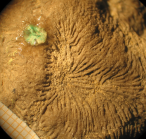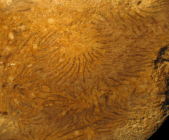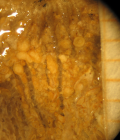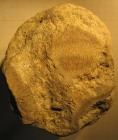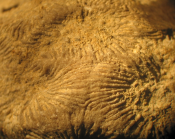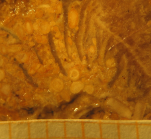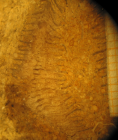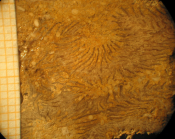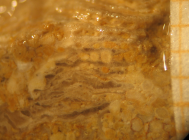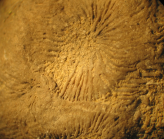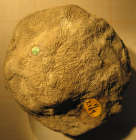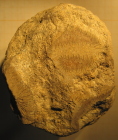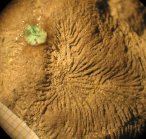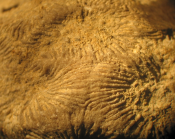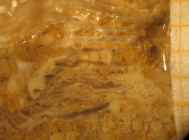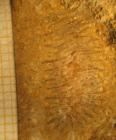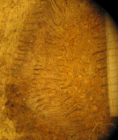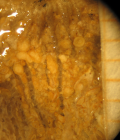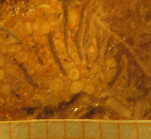
| Intro | | About | | Wiki | | Search traits | | Data explorer | | Literature | | Definitions | | Sources | | Webservices | | Statistics | | Feedback | | Editors | | Log in |
Scleractinia taxon detailsPhyllogyra Tomes, 1882 †
1438163 (urn:lsid:marinespecies.org:taxname:1438163)
accepted
Genus
Symphyllia etheridgei Duncan, 1872 † accepted as Phyllogyra etheridgei (Duncan, 1872) † (type by subsequent designation)
marine,
fossil only
Tomes RF. (1882). On the Madreporaria of the Inferior Oolite of the neighbourhood of Cheltenham and Gloucester. <em>Quarterly Journal of the Geological Society.</em> 38: 409-450, pl. 18., available online at http://jgslegacy.lyellcollection.org/cgi/doi/10.1144/GSL.JGS.1882.038.01-04.45 [details]
Description Massive meandroid corallum with short valleys. Septa of valleys not always present. No ambulacrum, just sometimes a small...
Description Massive meandroid corallum with short valleys. Septa of valleys not always present. No ambulacrum, just sometimes a small sulcus on the collines. Poorly elevated tholiform collines. No holotheca observed. Intracalicinal increase producing sinuous valleys with only one center in the width of the valley. New corallites occur also between valleys. Radial elements are compact free bicuneiform or attenuated, often curved, sometimes straight, confluent or not confluent on the collines. Distal edge with regular teeth (not well preserved on the lectotype); some trifid teeth typical for Montlivaltids observed at distal inner edge, lateral faces with acute granules or carinae(?), no pali. Montlivaltid microstructure. Hexameral symmetry cannot be deciphered, bilateral symmetry visible with curvature of septa. Endotheca made of dissepiments, columella absent, axial zone with a small fossa, synapticulae absent. Parathecal wall between valleys. [details] Description Massive meandroid corallum with short valleys. Septa of valleys not always present. No ambulacrum, just sometimes a small...
Description Massive meandroid corallum with short valleys. Septa of valleys not always present. No ambulacrum, just sometimes a small sulcus on the collines. Poorly elevated tholiform collines. No holotheca observed. Intracalicinal increase producing sinuous valleys with only one center in the width of the valley. New corallites occur also between valleys. Radial elements are compact free bicuneiform or attenuated, often curved, sometimes straight, confluent or not confluent on the collines. Distal edge with regular teeth (not well preserved on the lectotype); some trifid teeth typical for Montlivaltids observed at distal inner edge, lateral faces with acute granules or carinae(?), no pali. Montlivaltid microstructure. Hexameral symmetry cannot be deciphered, bilateral symmetry visible with curvature of septa. Endotheca made of dissepiments, columella absent, axial zone with a small fossa, synapticulae absent. Parathecal wall between valleys. [details] Distribution Western Europe; Middle Jurassic South America; Middle Jurassic
Distribution Western Europe; Middle Jurassic South America; Middle Jurassic [details]
Hoeksema, B. W.; Cairns, S. (2024). World List of Scleractinia. Phyllogyra Tomes, 1882 †. Accessed at: https://www.marinespecies.org/scleractinia/aphia.php?p=taxdetails&id=1438163 on 2024-10-11
Date action by
original description
Tomes RF. (1882). On the Madreporaria of the Inferior Oolite of the neighbourhood of Cheltenham and Gloucester. <em>Quarterly Journal of the Geological Society.</em> 38: 409-450, pl. 18., available online at http://jgslegacy.lyellcollection.org/cgi/doi/10.1144/GSL.JGS.1882.038.01-04.45 [details]
basis of record Cairns, S.D., R. Baron-Szabo, A.F. Budd, B. Lathuilière, E. Roniewicz, J. Stolarski & K.G. Johnson. (2010). Corallosphere. , available online at http://www.corallosphere.org [details] additional source Duncan PM (1884) A revision of the families and genera of the sclerodermic Zoantharia, Ed. & H., or Madreporaria (M. Rugosa excepted). Journal of the Linnean Society of London, 18: 1-204. [details] additional source Wells JW. (1936). The nomenclature and type species of some genera of recent and fossil corals. <em>American Journal of Science.</em> 31: 97-134., available online at https://ajsonline.org/article/61464 [details]  Present Present  Inaccurate Inaccurate  Introduced: alien Introduced: alien  Containing type locality Containing type locality
From editor or global species database
Comparison The genus is very close of Complexastrea but meandroid. [details]Description Massive meandroid corallum with short valleys. Septa of valleys not always present. No ambulacrum, just sometimes a small sulcus on the collines. Poorly elevated tholiform collines. No holotheca observed. Intracalicinal increase producing sinuous valleys with only one center in the width of the valley. New corallites occur also between valleys. Radial elements are compact free bicuneiform or attenuated, often curved, sometimes straight, confluent or not confluent on the collines. Distal edge with regular teeth (not well preserved on the lectotype); some trifid teeth typical for Montlivaltids observed at distal inner edge, lateral faces with acute granules or carinae(?), no pali. Montlivaltid microstructure. Hexameral symmetry cannot be deciphered, bilateral symmetry visible with curvature of septa. Endotheca made of dissepiments, columella absent, axial zone with a small fossa, synapticulae absent. Parathecal wall between valleys. [details] Description Massive meandroid corallum with short valleys. Septa of valleys not always present. No ambulacrum, just sometimes a small sulcus on the collines. Poorly elevated tholiform collines. No holotheca observed. Intracalicinal increase producing sinuous valleys with only one center in the width of the valley. New corallites occur also between valleys. Radial elements are compact free bicuneiform or attenuated, often curved, sometimes straight, confluent or not confluent on the collines. Distal edge with regular teeth (not well preserved on the lectotype); some trifid teeth typical for Montlivaltids observed at distal inner edge, lateral faces with acute granules or carinae(?), no pali. Montlivaltid microstructure. Hexameral symmetry cannot be deciphered, bilateral symmetry visible with curvature of septa. Endotheca made of dissepiments, columella absent, axial zone with a small fossa, synapticulae absent. Parathecal wall between valleys. [details] Distribution Western Europe; Middle Jurassic South America; Middle Jurassic [details] Morphology The genus is very close of Complexastrea but meandroid. [details] Type designation Subsequent designation by Wells (1936) [details] |
